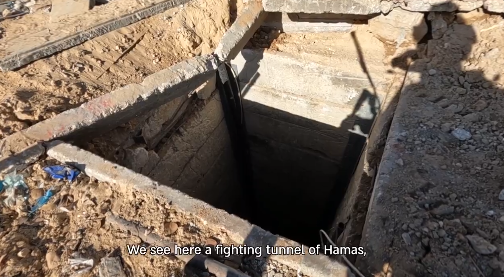“There is almost no home without a tunnel,” says Nahal Brigade commander Col. Yair Zuckerman.
By Batya Jerenberg, World Israel News
Israel’s months-long insistence on the need to clear out Rafah as the last military stronghold of Hamas has been vindicated as the IDF has penetrated deeper and deeper into the city over the last six weeks.
“The number of tunnels in this sector is the largest I have seen in the Strip,” Nahal Brigade commander Col. Yair Zuckerman told a contingent of Israeli journalists Tuesday who had been brought into the town on the Egyptian-Gazan border.
“There is almost no home without a tunnel,” he said, with passageways that connect whole neighborhoods both above ground and beneath.
“It’s not right to skip over them. We need to take care of them now, while we are here,” he added.
Soldiers fighting in Rafah have found hundreds of weapons, including material for making explosives, rocket-propelled grenades, and long-range rockets in the underground passageways, as well as Hamas command-and-control centers.
Whole apartment buildings, ostensibly for civilian residents, have been found to be Hamas military bases.
Many houses are wired to explode by remote control, Zuckerman said, and need to be cleared out slowly and carefully.
Four soldiers were killed last week when Hamas set off a bomb after they entered such a home, thinking that it was already clear.
“What we encountered here, we have not seen elsewhere,” Givati Brigade commander Col. Liron Batito told the press in turn. “This, in terms of the scope of the tunnels, the explosive devices and the traps. [Hamas] created an underground traffic system here, but also above-ground traffic systems, [by opening] passages between buildings so that they could move in ways hidden from view.”
“At the same time,” he continued, “they covered the area with cameras…. As soon as they detect a movement of an [IDF] force, there is someone standing nearby with a remote control to detonate an IED.”
Batito reassured the reporters that “We’ve studied the issue and we have the ways to neutralize these actions.”
Combat engineers have been busy destroying the terror infrastructure, which includes over 200 tunnel shafts from which terrorists regularly pop out to attack IDF forces.
The system is so interconnected that whole neighborhoods have been leveled.
Another very important series of tunnels that the engineers have taken care of are the 25 found at the southern edge of the town, crossing underneath the Philadelphi Corridor to Egypt that IDF Spokesman Rear Adm. Daniel Hagari called “Hamas’ oxygen pipeline” as they enabled a constant flow of smuggled weaponry into Gaza.
The above-ground Rafah crossing to Egypt was also a huge source of weapon resupply, according to the IDF, and it was the first target that the IDF took over when it commenced the Rafah operation last month.
Zuckerman said that the army believes it must control the Philadelphi corridor to prevent future smuggling efforts.
“You can’t just do it from the air,” he said. “You have to sit along the axis in one way or another.” According to him, no less than a brigade is needed for this task.
On the other hand, according to a Maariv report, at the end of the Rafah operation, the IDF prefers to leave the area, and carry out raids and entries with high frequency – once every few days, and sometimes even hours.
At the same time, the officers told the press that they are also preparing for other options, as ordered by the political echelon.
The IDF has said that the Rafah operation will be completed in a matter of weeks. Since almost all the civilians, numbering over 1.2 million people, fled the town as the IDF gradually entered, those who are left are Hamas fighters hiding mostly in the tunnels that still crisscross the town.
This makes the IDF’s job easier, as they do not have to worry so much about civilian casualties and can concentrate on eliminating the terrorists, more than 550 of whom have been killed so far.
Before entering Rafah, Israel said Hamas had four brigades of fighters there. By now, the IDF believes that perhaps as many as two brigades’ worth insinuated themselves among the civilians fleeing the area to IDF-approved safe zones.
The army is aware that these men could become the nucleus of a guerilla force, as Hamas switches tactics to take into account the new reality of its army’s demolishment.





